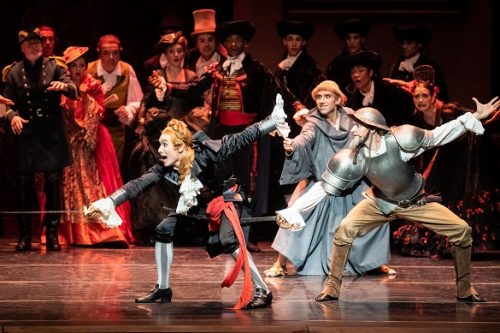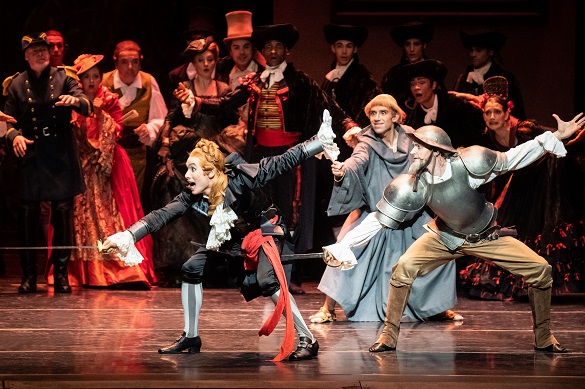 Austria Rudolf Nureyev’s Don Quixote: Dancers of Vienna State Ballet, Orchestra of the Vienna State Opera / Robert Reimer (conductor). Transmitted live (directed by Balázs Delbó) from the Vienna State Opera, 16.9.2023. (JPr)
Austria Rudolf Nureyev’s Don Quixote: Dancers of Vienna State Ballet, Orchestra of the Vienna State Opera / Robert Reimer (conductor). Transmitted live (directed by Balázs Delbó) from the Vienna State Opera, 16.9.2023. (JPr)

I do repeat myself but it is important to emphasise how Rudolf Nureyev’s influence lives on with many of those ballet companies he worked with thanks to his choreographies and artistic legacy. Of course, this is not just confined to Vienna as he is still held in the highest esteem by many of the world’s leading ballet companies including in Paris and Milan. Only in the UK does he seem mostly forgotten and The Royal Ballet could perhaps restage his 1968 The Nutcracker (the first ballet I saw at Covent Garden) as an alternative to their version by Sir Peter Wright that we are now over-familiar with and his 1975 The Sleeping Beauty and 1977 Romeo and Juliet (I have seen both many times) have recently disappeared from the programming of English National Ballet.
Looking at his 1966 Don Quixote for Vienna State Ballet I wondered if that might be because he demands so much of the dancers and it would expose any (possible) weaknesses in our homegrown companies. The principal dancers in this Don Quixote barely pause for breath over three acts and most looked as fresh at the end as they did at the start. Indeed the Russian-schooled, technically- and artistically-assured Liudmila Konovalova as Kitri/Dulcinea – who is in her 30s – even then seemed to shed a decade when it was all over; although her Basil, the otherwise charismatic Davide Dato, did seem to have his stamina sorely tested during the grand pas de deux and didn’t exactly soar.
Recently a ‘re-mastered, restored and re-orchestrated’ version of the 1973 film Nureyev, Sir Robert Helpmann and the Australian Ballet made of Don Quixote was shown in cinemas to mark its 50th anniversary. Sadly I knew nothing about that until too late although anyway I would rather dwell on what Nureyev has bequeathed us, as here in Vienna. I doubt too many young people would have watched Don Quixote in the cinema and so may need reminding how important Rudolf Nureyev was to many who began going to ballet in our formative years when he was dancing. It is now 85 years since his birth and 30 years (where has that time gone?) since his premature death. We will never see his like again and he can never be forgotten because of his zealotry in always giving male dancers – particularly himself – as much to do as possible in any new version of the classics. He may never have always got it perfectly right though what he did was often thought-provoking and spectacular. In the early 1980s I saw Nureyev dance in his legendary Swan Lake for Vienna State Ballet which he created in 1964 and which is still in their repertory and will be revived by them later this season. It remains one of my most cherished memories of going to the ballet. Nureyev’s choreography for Don Quixote is full of his trademark demanding balances, intricate footwork and armography.
The Vienna State Opera’s website tells us how Nureyev’s Don Quixote ‘remained in the Vienna repertoire for almost 20 years, from its world premiere until 1985, with Nureyev himself regularly taking to role of Basil. In 2011, Manuel Legris, who had danced several roles in the production in Paris, brought it back to where it had been created in a scrupulously worked reconstruction. Now Nureyev’s comedy ballet, which is a calling card for any company with the extreme technical demands it makes of the dancers, can once again be seen.’
I doubt anyone ever goes to Don Quixote for the story. It is, originally, a nineteenth-century Marius Petipa-Ludwig Minkus warhorse of a ballet. What we now see is based on an 1869 Bolshoi comic play staged by Petipa with music by Minkus which concentrated on a minor incident from Miguel de Cervantes’s original seventeenth-century novel. It is the story of the love of Kitri, a young girl, for Basil, a poor barber, and her rejection of a forced marriage to a rich nobleman Gamache. Now and then the Don and his comic sidekick, Sancho Panza, wander into the story mainly for Quixote to confuse Kitri with Dulcinea, his dream lady ‘of his heart’. It is basically a classical showcase for any ballet company, with the demanding Act III pas de deux just being the final showstopper in an evening of showstoppers.
It starts with a with a brief prologue set in Don Quixote’s dimly lit bed chamber. There the ageing nobleman – with a barber’s bowl on his head as a helmet and portrayed by the willowy Zsolt Török exuding self-righteous pomposity – enlists his servant Sancho Panza to accompany him on his quest to perform feats of chivalry and win the heart of his ideal woman Dulcinea. François-Eloi Lavignac’s Sancho Panza is jovial, well-upholstered and slightly disreputable. From then on we are totally immersed in the exotic world of a Spanish and Moorish-influenced Mediterranean city, nominally Barcelona, with its bustling public square, fringed by huge towers with cannons atop two of them. From the very start, Nureyev’s exuberant choreography for the ensemble numbers demands your attention and this dancing maelstrom requires the greatest virtuosity as well as some compelling acting from the gaggle of quirky characters we are introduced to. The close-up camerawork reveals interesting detail: at one point Gamache whilst wooing Kitri kisses her hands and you see her gesture to Basil as if saying ‘That’s how to treat a lady.’ (Jackson Carroll’s Gamache is rather too effete to be really PC for 2023 and a first cousin to the umbrella-wielding Alain in Sir Frederick Ashton’s La fille mal gardée.) The first act ends with two near-impossible one arm lifts for Basil and Kitri (brought off with aplomb) at the conclusion of their somewhat extended pas de deux before they escape the marriage plans her father, Lorenzo (a rather piratical-looking Igor Milos), has for her; though they will be pursued by Lorenzo, Gamache, Don Quixote and Sancho Panza.
The stage for the opening of Act II is dominated by a huge windmill in front of which there is a languidly beautiful pas de deux for Kitri and Basil before they are discovered by some gypsies who agree to hide them from their pursuers. A puppet theatre is brought on the stage where the story of Kitri and Basil is played out by young ballet students. Of course Don Quixote believes Kitri to be Dulcinea and tries to come to her aid and he destroys the theatre before attacking the windmill which he believes to be a gigantic enemy and get wounded for his pains.
What follows is some wonderful stagecraft as umbrellas are opened and closed to become the frightening monsters of the sleeping Don Quixote’s dreams and there is a stunning ‘floating’ vision of Kitri/Dulcinea where she is lifted by a concealed black-clad dancer and it gives the illusion of an ethereal being. We are quickly transported to an enchanted garden where the Queen of the Dryads – Olga Esina dancing with an imposing elegance – introduces Don Quixote to Dulcinea. There is dancing from all concerned of crispness and crystalline purity (Elena Bottaro notably caught the eye as Amor) and as the dryads drift away there is more than a hint of the swans in Swan Lake.

Act III begins with a tavern scene slightly reminiscent of a ballet version of Carmen especially since the toreador Espada who we first met with his fellow toreadors in Act I returns to duet with Ketevan Papava’s street dancer. Brendan Saye’s hot-blooded Espada dramatically stomps around – in a good way – more like the actual bull whilst Papava dances with considerable flair. Davide Dato goes OTT in a very funny ‘death’ scene because Lorenzo is still determined that Kitri should marry Gamache. Kitri asks Don Quixote to help them and he forces Lorenzo to allow Kitri to marry the ‘dying’ Basil who proceeds to make a miraculous recovery. Gamache is seething and challenges Don Quixote to a duel which is a wonderfully choreographed, fast-paced swordfight ending with Gamache’s humiliation. Time at last for the spirited wedding pas de deux which featured some rock-solid balances and impressive fouettés en tournant from Konovalova whilst Dato was clearly starting to tire and he especially found the changes of direction demanded challenging. After Don Quixote is caught professing his love for a disguised Gamache and humiliated himself this time he sets off with the loyal Sancho Panza seeking new adventures. Everyone else joins in with the clapping, twirling, high-energy and joyful – perpetuum mobile-like – finale.
As the friends of Kitri and Basil, townsfolk, bullfighters, gypsies and dryads, the corps de ballet excelled, dancing with consummate synchronicity when required and giving their characters elements of individuality if needed. The resilience and strength of the Vienna State Ballet shone through this performance. Just as Minkus’s music – effervescently orchestrated by John Lanchbery – did too! Under German conductor Robert Reimer’s experienced conducting the orchestra – of course members of the Vienna Philharmonic – brought a sense of ebullience and all the necessary Spanish colours to the dynamic movement we saw from the dancers in this Viennese revival of Don Quixote which did Rudolf Nureyev proud.
Jim Pritchard
Creatives:
Choreography – Rudolf Nureyev
Music – Ludwig Minkus (arranged by John Lanchbery)
Scenery and Costume design – Nicholas Georgiadis
Lighting design – Marc Anrochte
Staging – Florence Clerc, Lukas Gaudernak, Jean Christophe Lesage
Cast (included):
Kitri / Dulcinea – Liudmila Konovalova
Basil – Davide Dato
Don Quixote – Zsolt Török
Sancho Panza – François-Eloi Lavignac
Gamache – Jackson Carroll
Lorenzo – Igor Milos
Two friends of Kitri – Sonia Dvořák, Aleksandra Liashenko
Espada – Brendan Saye
A street dancer – Ketevan Papava
The Queen of the Dryads – Olga Esina
Amor – Elena Bottaro
First bridesmaid – Natalya Butchko
A Gypsy – Arne Vanderbilt

Nureyev was a highly musical dancer and choreographer. Furthermore, Nureyev was a good pianist and, in his last years, he conducted an orchestra. As the reviewer writes, “We will never see his like again”. His work should be compulsory study material for dancers and choreographers.